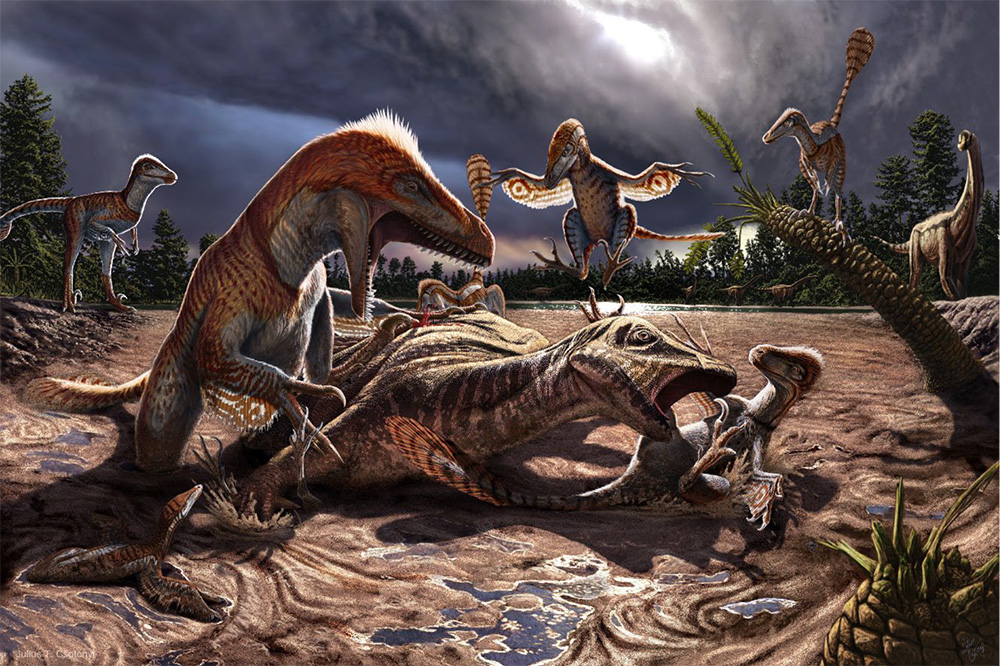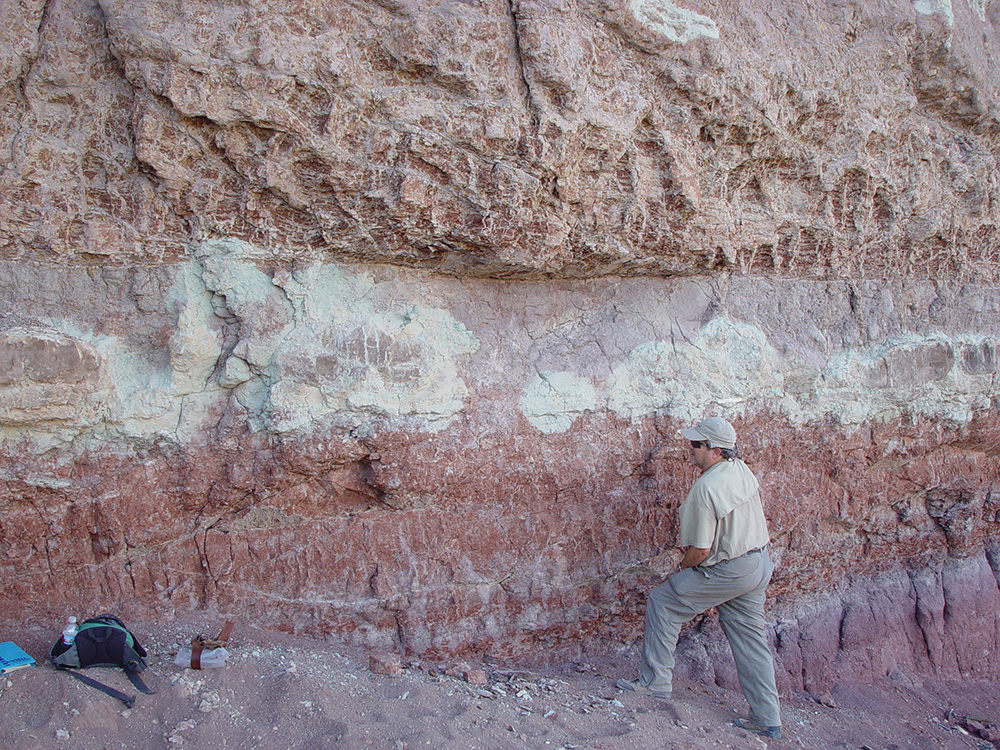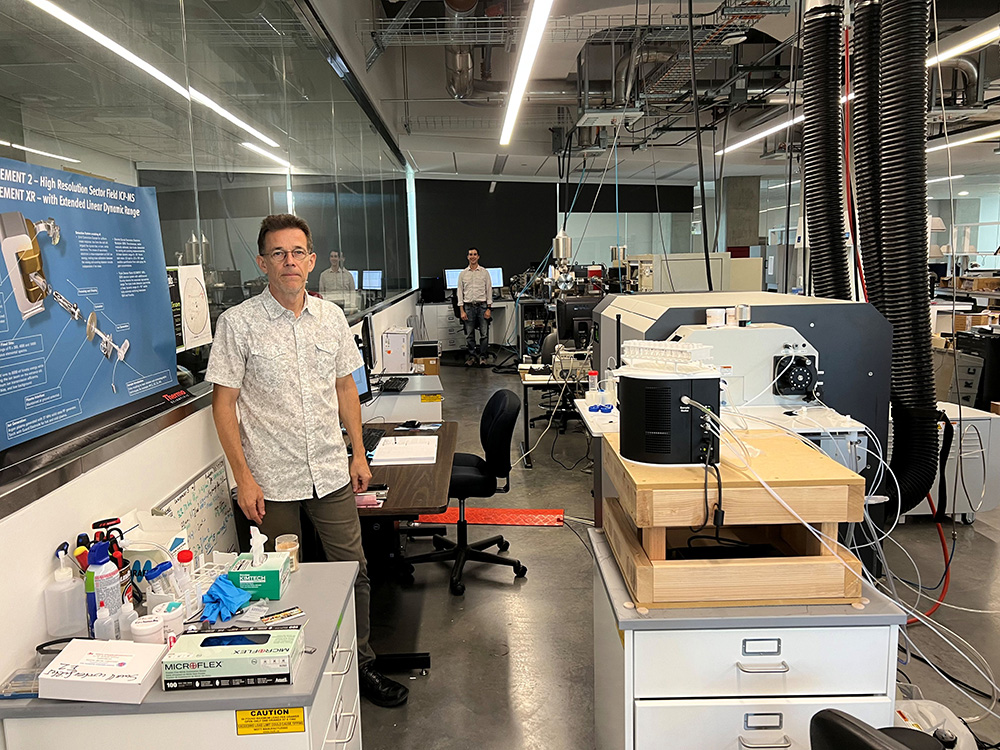KU geochemists determine age of the dinosaur Utahraptor

LAWRENCE — Three scientists, three state geological surveys, a common fascination with dinosaurs, and one simple yet profound question: Just how old are the rocks that preserve the world’s biggest “raptor,” Utahraptor?
More than a decade ago, Greg Ludvigson, emeritus senior scientist with the Kansas Geological Survey, Jim Kirkland, state paleontologist with the Utah Geological Survey, and Matt Joeckel, state geologist and director of the Conservation and Survey Division at the University of Nebraska–Lincoln, joined together to tackle that question.
They succeeded beyond their greatest expectations.

“We determined the age of the dinosaur Utahraptor and found that it was much older than previously supposed,” Ludvigson said. “That finding has important implications for the evolutionary history of dinosaurs. We also learned to our complete surprise that the rock strata from the Stikes Dinosaur Quarry were deposited during a global change episode known as the Weissert Event. This is an agenda-setting discovery that will reverberate for decades.”
The scientists described their findings in a recent issue of the journal Geosciences.
The fieldwork took place in Utah at the well-known Utahraptor Ridge site, named for the larger cousins of the velociraptor dinosaur stars of the “Jurassic Park” movies. The ridge is home to Stikes Quarry, a fossil quicksand deposit packed with dinosaur fossils that are largely intact and preserved in much the same positions as when they died. Stikes Quarry is part of the Cedar Mountain Formation, a rock unit that contains fossils of more kinds of dinosaurs than any formation in the world.

To answer their question — how old are these rocks? — researchers took two different research approaches.
One path — uranium/lead dating of zircon crystals — involved analyzing samples of these minerals collected at different depths in the rock layers. The second looked at changes in the relative abundance of two types of stable carbon isotopes found in buried organic matter and linked results to specific periods in Earth’s history when global changes in the carbon cycle were known to have occurred.
The big takeaway? Rocks in the Yellow Cat Member of the Cedar Mountain Formation — and the Utahraptor fossils found within — are 10 million years older than previously known. Earlier estimates put the age of the rocks and fossils at 125 million years old.
“That’s a lot of evolutionary time,” Ludvigson said. “It’s kind of a vindication of something Jim’s argued for some time, but arguing doesn’t put an absolute age on it, and that’s important to him.”
The revised age indicates the rocks at the Stikes Quarry are at least 135 million years old. The lower part of the Yellow Cat Member encompasses even older strata. The findings narrow the gap in the rock record at the boundary between the Jurassic and Cretaceous periods in Utah.
“Before, we had a 25 million year gap between them,” said Kirkland, who first named and described the dinosaur Utahraptor ostrommaysi in 1993. “That’s a third of the age of mammals, more than double the length of time for hominid evolution. It’s a big chunk of time. Anything can happen over 25 million years if you have no record of what’s going on. We’ve plugged that record, for the most part.”
The oldest rock sample analyzed produced an age of 139.7 million years plus or minus 2.2 million, showing that rocks in the lower part of the Yellow Cat Member at Utahraptor Ridge belong in the oldest stage (Berriasian) of the Cretaceous Period.
Many scientists, one goal
Behind the discoveries is a decade-plus of scientific collaboration that combined the work of 11 researchers in Utah, Nebraska, Arkansas and Kansas. Their work merged the fields of paleontology and geochemical laboratory analyses.
“We were mainly carried forward by the belief that this was important work and we’d find a way to get it done,” Ludvigson said. “Everyone had full-time jobs with other duties. This was a backburner project. When we could carve out snippets of time, we’d do these things.”
One of Ludvigson’s longtime goals was to pursue a record of global carbon cycle changes in mid-Cretaceous terrestrial deposits. The so-called carbon isotope excursions are known to have coincided with global changes that had profound paleoenvironmental consequences, including abrupt climate changes and extinction events. Such changes were already well documented in marine deposits and in terrestrial plant fossils preserved in marine deposits.
Ludvigson theorized he should be able to find similar changes in rocks of the same age formed on dry land, and more than 25 years ago, he set out to connect with the scientists most knowledgeable about Cretaceous terrestrial rocks — those who study dinosaurs. That’s how he met Kirkland, and they discovered Ludvigson’s goals overlapped with Kirkland’s studies of the dinosaur fossils. Kirkland had extensive knowledge about the dinosaurs found in the Cedar Mountain Formation, but he needed a collaborator to help nail down the age of the rocks in the dinosaur bone beds.
In 2014, Ludvigson, Joeckel, and Andreas Möller, associate professor of geology at KU, traveled to Utah to collect samples for zircon dating. Kirkland invited them to be present when workers excavated a haul road in the cliff side at Utahraptor Ridge to remove a 9-ton, plaster-jacketed block of the bone bed at Stikes Quarry, an opportunity to study the site when the rock strata were best exposed. When they arrived, they found another scientist with KU ties already there collecting samples of soil organic matter to analyze carbon cycle changes. KU alumna Celina Suarez, associate professor of geosciences at the University of Arkansas, had arranged for her graduate student, Garrett Hatzell, to collect samples there for organic carbon isotope analysis.
Both zircon dating and carbon isotope analyses would yield information about the age of the rocks at Stikes Quarry, the two teams decided to coordinate their efforts. Though Ludvigson’s duties recalled him to KU before all of the samples were collected, Joeckel remained to coordinate both teams’ efforts.
“I said, Matt, you must make certain that the positions of the zircon samples and the carbon samples are accurately placed within the same measured stratigraphic succession,” Ludvigson said. “At the end of the day, we collected samples that were in known positions so that the two data sets would speak to each other.”
What followed was years of geochemical lab work. Answers that gave the scientists an inkling they were on track to discover something really exciting began to emerge as early as 2015.
Zircon dating: uranium-lead geochronology at KU
Zircon dating works like this: Zircon crystals are among the most durable minerals on Earth. They contain trace elements, such as uranium, that undergo radioactive decay at known rates, producing “daughter isotopes,” including radiogenic lead. If those elements remain intact within a zircon crystal — if the mineral hasn’t been chemically altered — scientists can measure the abundance of the uranium isotopes and their daughter isotopes and thus gauge how old the zircon crystal is.
To obtain high-precision ages, the team looked for fossil volcanic ash deposits. Such deposits are relatively common in marine rocks, formed when ash fell into what was then a sea, but are not as often found in terrestrial rocks, such as those at Utahraptor Ridge. Surface processes, such as shrink-swell phenomena in soils and burrowing activity by soil-dwelling organisms, can mix sediments in soils and obscure the depositional record.
“We tried an innovative application of a newer concept — cryptotephras — to ancient buried soils,” Ludvigson said. The concept refers to laboratory separation of microscopic fragments of volcanic ash in soils that are not visible to the naked eye to find the volcanogenic zircon crystals.
The precise analyses and number crunching associated with these analyses took place at KU during the height of the COVID-19 pandemic, when precautions limited scientists’ ability to work together and only one person could occupy a lab at a time.
The initial analysis, performed by Möller using a laser to zap zircon crystals, resulted in a deposition age of 136 million years ago but came with an inherent 2% uncertainty, or a range of nearly 5.5 million years. Ludvigson and Möller knew that they could do better.
Another member of the team, Noah McLean, associate professor of geology at KU, performed additional analyses using a high-precision technique that involved a time-intensive procedure using chemicals to dissolve the zircons. McLean’s analyses yielded absolute ages for the samples with uncertainties of less than 1 million years.
Detecting changes in Earth’s carbon cycle
While the KU team pursued answers from zircon crystals, Celina Suarez’s team in Arkansas began studying the soil organic matter samples they collected in Utah to detect changes in Earth’s carbon cycle. Their process involved analyzing the relationship between two types of carbon, known as carbon-13 and carbon-12. The carbon-13/carbon-12 ratio yields a snapshot of Earth’s ocean-atmosphere system at any given time and can improve correlations between the ages of marine and terrestrial rocks. The Cretaceous Period is noted for multiple carbon isotope excursions — such as the well-known Weissert Event, which recorded abrupt changes in atmospheric carbon dioxide (CO2) concentrations related to global volcanic activity.
“We first began to suspect that we had a record of the Weissert Event in 2015 but wanted to be very careful that we were absolutely certain about the reliability of the results,” Ludvigson said.
The initial processing and analyses of the carbon isotope samples took place at the University of Arkansas. During the pandemic, those organic matter samples were transferred to the Kansas Geological Survey for additional processing and analyses at the Keck Paleoenvironmental and Environmental Stable Isotope Laboratory directed by KU associate professor of geology Marina Suarez, sister of Celina Suarez. The data published in the Geosciences paper were all generated at KU during the shutdown period of the pandemic.
With this second set of results from the KU lab, Marina Suarez, Celina Suarez, and Ludvigson conferred.
“There was greater variability in replicates run in different labs than we expected,” Marina Suarez said. “That required that we go through each sample individually (more than 100) to investigate the possible reason for this.”
The researchers traced the variability in results to the pretreatment methods used to prepare some of the samples.
“Once these were identified, things fell into place,” she said. “It highlights how much attention to detail is needed in our studies. Every little bit of information is important.”
The two approaches — zircon dating and carbon isotope analysis — “gave us two independent lines of isotopic geologic evidence for the age of the deposits at Utahraptor Ridge — a real breakthrough,” Ludvigson said. “If you use multiple techniques and they tell the same story, it increases your confidence in the final result.”
Opening new avenues of research
The Utahraptor Ridge findings have resulted in a succession of papers and presentations at national and international conferences. In addition to the findings reported in Geosciences of the age of the Yellow Cat Member and Utahraptor fossils, papers in 2010 and 2015 showed that Cretaceous carbon isotope changes are recorded in terrestrial deposits just as they are in marine deposits of the same age, as Ludvigson had theorized.
“In the end, we found multiple carbon isotope excursions extending the record at Utahraptor Ridge back to about 140 million years ago, a much longer record than previously known,” Ludvigson said. “Moreover, the 135 million year age of strata just below the Stikes Quarry coincides with the most recently accepted age of the Weissert Event. The carbon isotope stratigraphic interpretation led by the Suarez sisters and geochronologic results from zircon dating are in agreement. These results confirm Kirkland’s long-held view that the Yellow Cat Member of the Cedar Mountain Formation contains a much longer geologic record than was previously documented.”
“It’s been a good collaboration,” Kirkland said. “We’ve argued about stuff over the years to no end, but that’s how you hone the ax of scientific knowledge.”
Beyond their current findings, Ludvigson, Kirkland, Joeckel, and their colleagues have unlocked new avenues for future research. “We’ve opened up this can of worms that’s going to keep the next generation busy figuring out what’s going on and why,” Kirkland said.
Marina Suarez, one of the new generation of scientists poised to continue pursuing questions raised by the new research, sees the potential for significant new discoveries in the years ahead.
“We are coming to understand that at least for the Cedar Mountain Formation, we have a much longer record of the past than we thought when I first started working in the formation as an undergraduate,” she said. “This has implications for understanding the evolution of dinosaurs and the change from Jurassic dinosaurs to Cretaceous dinosaurs. In addition, we are able to derive climate conditions from rocks and with the added dimension of time, we are able to understand the rate of changes in climate to better understand how climate can change in the future and how biota responds to those changes.”
For more information, contact Greg Ludvigson, gludvigson@ku.edu. For information about Utahraptor, contact James Kirkland, jameskirkland@utah.gov.
Top image: Csotonyi illustration: Portrayal of Utahraptors and prey trapped in quicksand deposit of the Stikes Quarry bone bed at Utahraptor Ridge. Credit and copyright: Julius Csotonyi, natural history illustrator, used by permission.
Photo: Greg Ludvigson on outcrop of colorful buried soils of the Yellow Cat Member in May 2009. Photo courtesy of Matt Joeckel.
Photo: Andreas Möller and Noah McLean at the Isotope Geochemistry Laboratory in the KU Department of Geology.